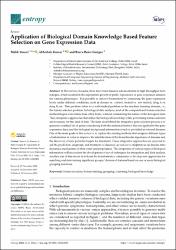| dc.contributor.author | Yousef, Malik | |
| dc.contributor.author | Kumar, Abhishek | |
| dc.contributor.author | Bakir-Gungor, Burcu | |
| dc.date.accessioned | 2022-03-01T08:30:02Z | |
| dc.date.available | 2022-03-01T08:30:02Z | |
| dc.date.issued | 2021 | en_US |
| dc.identifier.issn | 1099-4300 | |
| dc.identifier.other | PubMed ID33374969 | |
| dc.identifier.uri | https //doi.org/10.3390/e23010002 | |
| dc.identifier.uri | https://hdl.handle.net/20.500.12573/1205 | |
| dc.description | A.K. is recipient of Ramalingaswami Re-Retry Faculty Fellowship (Grant; BT/RLF/Re-entry/38/2017). The work of B.B.G. has been supported by the Abdullah Gul University Support Foundation (AGUV). The work of M.Y. has been supported by the Zefat Academic College. | en_US |
| dc.description.abstract | In the last two decades, there have been massive advancements in high throughput technologies, which resulted in the exponential growth of public repositories of gene expression datasets for various phenotypes. It is possible to unravel biomarkers by comparing the gene expression levels under different conditions, such as disease vs. control, treated vs. not treated, drug A vs. drug B, etc. This problem refers to a well-studied problem in the machine learning domain, i.e., the feature selection problem. In biological data analysis, most of the computational feature selection methodologies were taken from other fields, without considering the nature of the biological data. Thus, integrative approaches that utilize the biological knowledge while performing feature selection are necessary for this kind of data. The main idea behind the integrative gene selection process is to generate a ranked list of genes considering both the statistical metrics that are applied to the gene expression data, and the biological background information which is provided as external datasets. One of the main goals of this review is to explore the existing methods that integrate different types of information in order to improve the identification of the biomolecular signatures of diseases and the discovery of new potential targets for treatment. These integrative approaches are expected to aid the prediction, diagnosis, and treatment of diseases, as well as to enlighten us on disease state dynamics, mechanisms of their onset and progression. The integration of various types of biological information will necessitate the development of novel techniques for integration and data analysis. Another aim of this review is to boost the bioinformatics community to develop new approaches for searching and determining significant groups/clusters of features based on one or more biological grouping functions. | en_US |
| dc.description.sponsorship | Ramalingaswami Re-Retry Faculty Fellowship BT/RLF/Re-entry/38/2017
Abdullah Gul University
Appeared in source as:Abdullah Gul University Support Foundation (AGUV) | en_US |
| dc.language.iso | eng | en_US |
| dc.publisher | MDPIST ALBAN-ANLAGE 66, CH-4052 BASEL, SWITZERLAND | en_US |
| dc.relation.isversionof | 10.3390/e23010002 | en_US |
| dc.rights | info:eu-repo/semantics/openAccess | en_US |
| dc.subject | feature selection | en_US |
| dc.subject | feature ranking | en_US |
| dc.subject | grouping | en_US |
| dc.subject | clustering | en_US |
| dc.subject | biological knowledge | en_US |
| dc.title | Application of Biological Domain Knowledge Based Feature Selection on Gene Expression Data | en_US |
| dc.type | review | en_US |
| dc.contributor.department | AGÜ, Mühendislik Fakültesi, Bilgisayar Mühendisliği Bölümü | en_US |
| dc.contributor.institutionauthor | Bakir-Gungor, Burcu | |
| dc.identifier.volume | Volume 23 Issue 1 | en_US |
| dc.relation.journal | ENTROPY | en_US |
| dc.relation.publicationcategory | Diğer | en_US |


















